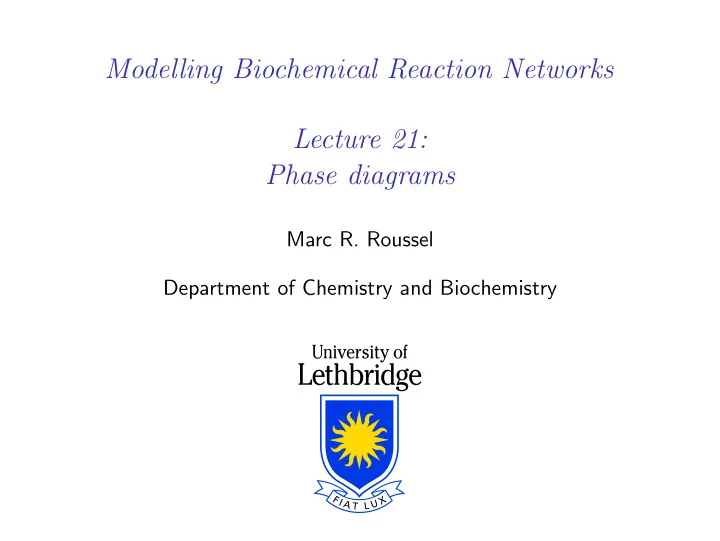

Modelling Biochemical Reaction Networks Lecture 21: Phase diagrams Marc R. Roussel Department of Chemistry and Biochemistry
Phase diagrams ◮ Bifurcation diagrams show us, among other things, where bifurcations occur as we vary the parameters of a model. ◮ We may also want to know in what region of parameter space certain behaviors may be observed. A diagram representing this information is called a phase diagram. ◮ A phase diagram is not to be confused with phase space or the phase plane. Language of nonlinear dynamics comes from several preexisting disciplines: phase space (and plane) from mechanics, phase diagram from thermodynamics/statistical mechanics
Phase diagrams from auto ◮ Auto can compute certain types of phase diagrams, namely phase diagrams arising from limit points and Hopf points ◮ General procedure: 1. Find a steady state in xpp . 2. Compute a bifurcation diagram. 3. Grab a limit point or Hopf point. 4. In the auto Axes dialog, choose a Two par diagram and set up the axes for your two parameters. 5. Run auto again. If necessary, grab the original point again, changing the sign of Ds to complete the curve. You may also grab additional points from the original bifurcation diagram to generate additional bifurcation curves in your phase diagram. ( Grab will behave a little oddly because you are actually traversing you original bifurcation diagram, and not your phase diagram.)
Phase diagram of the genetic toggle switch Bifurcation diagram OONA 1 0.8 0.6 0.4 0.2 0 0 0.0005 0.001 0.0015 0.002 hA
Phase diagram of the genetic toggle switch Bifurcation diagram ◮ Once you have the bifurcation diagram, note the limit points: Label 3: h A = 0 . 001 248 Label 10: h A = 0 . 000 2548 (Labels will depend on order of computation and other minor details.) ◮ Also note the labels of all the end points. This will be useful to figure out where you are in your phase diagram later. In this case, we have EPs at labeled points 1, 6, 7 and 12.
Phase diagram of the genetic toggle switch ◮ Now grab LP 3 (or equivalent). ◮ Set up Two par axes for h A × h B diagram. Set both axes to run from 0 to 0.002. ◮ Click on Run . ◮ Grab LP 3 again, reverse the sign of Ds in the Numerics menu , and click on Run . ◮ Now go look for new EPs. Specifically, look for one at the left end of the curve drawn so far in your phase diagram. In my case, I find a new EP labeled 16. ◮ Click on Run and the phase diagram should be completed.
Phase diagram of the genetic toggle switch hB 0.002 0.0015 0.001 0.0005 0 0 0.0005 0.001 0.0015 0.002 hA ◮ Note the cusp.
Phase diagram of the genetic toggle switch hB h A 0.002 O on O off A + 2B ⇀ − ↽ − A 0.0015 f A 0.001 h B O on O off B + 2A ⇀ − 0.0005 ↽ − B f B 0 0 0.0005 0.001 0.0015 0.002 hA ◮ Imagine that we start at at very small value of h B , but not too small a value of h A . Here we expect gene A to be off and gene B to be on since A doesn’t bind O on B very well. ◮ As we increase h B , we cross a first line of saddle-node bifurcations, creating the second steady state with A on and B off. ◮ Eventually, A becomes too good at binding O on B , and the A off/B on steady state is destroyed as we cross a second line of saddle-node bifurcations.
Phase diagram of the genetic toggle switch hB 0.002 0.0015 A on B off Bistability 0.001 0.0005 A off/B on 0 0 0.0005 0.001 0.0015 0.002 hA ◮ Note the analogy of the cusp to a critical point in thermodynamics: By going around the cusp, we can get from the A on/B off state to the A off/B on state without passing through the region of coexistence (bistability).
Phase diagram of the genetic toggle switch More on the cusp ◮ The two lines of saddle node bifurcations meet at the cusp. It is reasonable to ask what the bifurcation diagram looks like near this point. ◮ Blow up the region of the cusp by rescaling the axes so they run from (e.g.) 0 to 0.0002. Go to the labeled point nearest to the cusp, then use the cursor keys to get to the cusp itself. Grab this point. h A = 8 × 10 − 5 , h B = 3 . 556 × 10 − 5 . ◮ Set up hi-lo axes for a new bifurcation diagram. In particular, set Ymax to 1. ◮ Set Par Max to 0.0002 in Numerics . ◮ Do File → Reset diagram , and then Clear . ◮ Now Run → Steady state .
Phase diagram of the genetic toggle switch More on the cusp ◮ It is very difficult to complete the bifurcation diagram from here because of the vertical segment, which messes up the interpretation of Ds . Instead, grab another labeled point (any one will do). Reset the diagram, then generate the diagram starting from this point, making sure to extend it in both directions.
Phase diagram of the genetic toggle switch More on the cusp OONA 1 0.8 0.6 0.4 0.2 0 0 5e-05 0.0001 0.00015 0.0002 hA ◮ The cusp in the phase diagram corresponds to a change in shape of the bifurcation diagram from S-shaped to sigmoidal. ◮ Note that the two steady states (high O on A and low O on A ) still appear, but not at the same time.
Recommend
More recommend